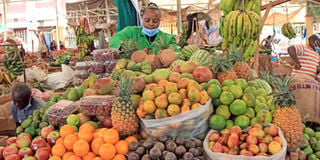The socio-economic impact of public debt on ‘Wanjiku’
Sponsored by OXFAM Kenya

A small-scale trader in Nyeri town. Kenya's big debt burden is pushing the tax collector to slap such traders with more tax. Joseph Kanyi | Nation
By Wanjiru Gikonyo
At the beginning of this year, economist David Ndii warned in an article titled, “Of Tigers, Debt Merchants and 2020 Vision”, that the debt crisis in Kenya was at a worrying level.
Over the last few years, Kenya’s rising public debt has been a point of discussion in many macroeconomic discourses, with organisations such as the International Monetary Fund (IMF), the World Bank, the African Development Bank (AfDB) and global credit rating agencies raising concerns on Kenya’s economic outlook.
In October 2018, the IMF downgraded Kenya from “low” to “medium” risk of debt distress and then to “high” in May 2020.
Kenya’s current level of indebtedness is alarming. Although this is partly because of the Covid-19 pandemic, the country was already facing an imminent public debt challenge prior to the contagion.
There are two underlining drivers of the burgeoning public debt in Kenya and across Africa: A return to an infrastructure-led development paradigm; and a deterioration of the quality of development finance.
The first factor, the infrastructure-led development paradigm, has helped to fuel an upsurge in foreign commercial debt available to Kenya.
Kenya’s portfolio includes a steep growth of commercial debt reaching Ksh2.57 billion in 2018. The country has procured both syndicated loans and bond issuances in the foreign debt market. There has also been stable growth of multilateral debts, with the World Bank’s International Development Association (IDA) and AfDB being the main funders (growing 39 percent in the period). About seven percent has come from the new funding by China.
Kenya has been increasingly careening towards short-term financing with a growing portfolio of Treasury Bills and decreasing share of Treasury Bonds. In 2002, multilateral lenders, who lend on more favourable terms than bilateral donors, accounted for two-thirds of Kenya’s foreign debt, which put it at 38 percent of the country’s total debt.
These neo-liberal strategies on debt financing have left the Kenyan economy gasping for air in the intensive care unit. The revenue collected by the Kenya Revenue Authority (KRA) mostly goes into servicing these loans, leading to a reduction in funds allocated to education, health, social services and agriculture, which as a result has seriously undermined the living conditions of the majority of Kenyans.
It is obvious to anyone living in Kenya that a few citizens continue to benefit from systemic corruption within the government, and that little to no accountability is forthcoming when government is called upon to account for the multibillion-shilling projects that it has undertaken. The result is that the State has systematically favoured the enrichment of a small and already wealthy minority.
To keep up the pace of revenue collection, Kenya Revenue Authority has been ‘innovating’ new tax categories aimed at collecting more money from citizens who are already burdened by the numerous tax categories in existence.
This year, for example, saw the return of the turnover tax. The new tax was aimed at collecting revenue from businesses whose annual sales did not exceed Ksh5 million. In simplified terms, this tax targets small and micro businesses, which in Kenya refers to the average mama-mboga, cybercafé owners, and other tiny start-ups estimated to constitute about 2.7 million informal traders.
For starters, the new tax would require these informal traders to pay three percent on their gross sales. While this amount does not seem to be steep at first, close analysis at its targeted audience reveals scary outcomes. For every Ksh100 mama-mboga makes, she is required to pay Ksh3, in addition to her other tax obligations. Any late payment of such tax would result in a five percent fine on the due tax with late filings being penalised at Ksh5,000 for each month – an amount quite steep for the small trader.
Furthermore, the new turnover tax would require these small traders to similarly pay a presumptive tax of 15 percent of the amount payable for a single business permit. This would translate, for example, into the average cybercafé operator in Nairobi being required to pay Ksh3,000 as additional tax above the annual Ksh20,000 business permit.
In recent times, as part of measures to cushion small and medium scale businesses from the impact of the Coronavirus pandemic, the government has reduced the tax from an initial three to one percent, as well as increased the cap for those liable to pay the tax levy from the current Ksh5 million annually to Ksh50 million per year. However, with the dwindling public coffers and a shrinking tax base, it is yet to be seen whether this shall be maintained beyond 2020.
With the government looking to expand the tax categories in the country to widen the tax base, it is worrying to see the President recently turn his eyes to the boda-boda industry, citing it as a lucrative business and referring to its collective potential to bring in revenues of more than Ksh350 billion a year. This statement should not be overlooked. The government might just introduce further taxation of the common boda-boda operator who takes home an average of Ksh700 a day. A further tax introduction on such persons would not only mean over taxation but the adverse effects could lead to a paralysis of average income, which could exacerbate the deficient living standards, with the economy already on a downward spiral.
______________
The author is the National Coordinator of The Institute for Social Accountability (TISA)


